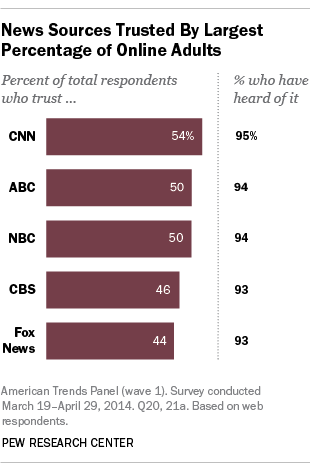
In 2014, CNN was the most trusted political news source over ABC, NBC, CBS, and Fox News among four of every ten adult online adults who had heard of these companies.
However, under the leadership of previous leader Jeff Zucker, the network’s reliability came into question as commentators started to put forth more opinions than ever before during the Trump Administration. Anderson Cooper, for example, is one of the network’s popular broadcasters and is known to have compared Trump to “an obese turtle on its back, flailing in the hot sun, realizing his time is over.” Amid this rather recent shift in tone, has CNN remained a reliable source of news, or has its opinion-style approach to the news reduced the accuracy of its reporting? Let’s find out.

Source: Pew Research
Does Reliability Matter?
Reliability, in general, refers to how trustworthy or accurate information, or in this case, a news source is. If we consider this definition, it quickly becomes clear why reliability is important in media sources. If we can’t trust the things we read then there isn’t much of a point in continuing to consume content from that source, after all. So how exactly can we gauge the reliability of a news source anyways?
There are several potential measures of reliability to look out for when trying to determine whether a media source is reliable or not. Red flags for an unreliable article can include the presence of wild unsubstantiated claims, facts dependent on other unreliable sources, heavy use of opinionated language, and more. Some indicators of a reliable news source, on the other hand, include things like:
- Absence of subjective/opinionated language in articles
- Credible sources cited (e.g., neutral sources, .gov, .edu websites)
- Facts and statistics backed by multiple relevant outside sources
- Use of primary sources when possible (e.g., interviews, quotes)
- Information that remains consistent across news sources
So How Does CNN Fair?
The political reliability index developed by Biasly objectively assesses news organizations’ accuracy and trustworthiness. CNN’s overall Reliability Score has been rated as ‘Good’ by Biasly. This rating is a weighted average of two distinct scores: the Fact Analysis Score and the Source Analysis Score, each evaluating separate components of CNN’s Reliability. When computing the Average Reliability of the article the Fact Analysis score is more heavily weighted. These ratings are as follows in the next two paragraphs:
CNN’s Fact Analysis Score is ‘Good,’ which suggests readers can trust most of CNN’s content online. The Fact Analysis score focuses more on the accuracy of claims, facts, and sources presented in the article and any hints of selection and omission bias, which we will discuss further in the article.
CNN’s Source Analysis Score is ‘Fair,’ which suggests readers can trust some of the sources, links, and quotes provided by the news source. This score, which is based on A.I., focuses on assessing the quality of sources and quotes used including their number, lengths, uniqueness, and diversity.
However, since these scores are based on percentages and averages, individual articles could be more or less trustworthy depending on the context, author, and other factors. Our findings show that CNN’s reliability is mostly but not all factual because they have retracted several stories in the past or had pieces that were not factual.
Let us analyze the supporting data for CNN’s rankings and discuss what to watch out for while searching for trustworthy news sources.
CNN Accuracy and Reliability
Political leanings and bias are a great determining factor in news reliability. Like many other news outlets, CNN is often accused of prioritizing a political agenda over reporting the facts, which has cast doubt over the network’s reliability and marred its reputation. But how true is this, really? One can find answers by assessing the accuracy of CNN’s news articles — or how well a network is able to back up its claims with facts. When evaluating the accuracy and factual correctness of an article, you’ll want to look for omission and selection bias.
Selection bias is when stories and facts are selected or deselected, often on ideological grounds, to create a narrative in support of the new sources’ ideology. Omission bias, on the other hand, is when different opinions and political views regarding a situation are left out so that the reader is only exposed to the ideological perspective supported by the author. It’s important to keep in mind these two types of biases when trying to assess an article’s level of accuracy.
Biasly rates accuracy on a percentage scale of 1-100, with 1 being the least accurate and 100 the most accurate. Ratings are determined by measuring claims with factually-backed reasoning, credible sources, and the number of credible external sources used within an article. CNN scored “Good” in terms of reliability based on the 18 articles its analysts rated, which means the average news article CNN publishes tends to be decently reliable.
Biasly’s website has an entire page that provides reliability and accuracy ratings for recently published CNN articles. While the reliability score shifts between articles, they all tend to fall within the average range. However, the more drastic fluctuations in reliability tend to result from bias — particularly omission and selection bias, which means that news articles demonstrating political bias score lower in reliability than neutral articles.
We will go into further analysis with examples of CNN’s reliability including its use of selection and omission bias and the quality of sources and facts used.
Analysis of Reliability in CNN Opinion Pieces
We’ve discussed opinion thus far as something to avoid in maintaining reliability, but this is not the standard for every style of journalism. Opinion pieces are a type of reporting that is not meant to be objective. Rather, they are designed to be an outlet for those who want to put forth a specific viewpoint and persuade readers to their side of an issue. These types of articles, due to their subjective nature, tend to be less reliable. Still, they can often be worth reading for the sake of broadening one’s understanding of various viewpoints across the political spectrum.
A good example of reliability problems with CNN opinions is their tendency to promote false information that serves left-leaning causes and individuals; over the years, CNN opinions have spread the Jussie Smollett false hate crime narrative, denied and downplayed the Hunter Biden laptop story, mischaracterized Joe Rogan’s use of Ivermectin, and pushed the debunked Russia Hoax. CNN’s devotion to these narratives and others has cost its reporters, anchors, pundits, and the network as a whole its reliability and ratings.
Quality of Sources and Facts Used
CNN’s biased articles with lower reliability ratings result from its lack of authoritative sources to back its claims as well as the inaccuracy of many claims made. For example, the article “Senate Democratic leaders want members to hold firm against ‘lethal’ GOP amendments on relief bill” received an analyst bias score of Moderately Liberal, an author bias score of Moderately Liberal, and a lower-than-average reliability score of “Fair.” This score can be partly attributed to the author’s failure to link to any website outside of CNN and its use of only Democrat sources, such as Dick Durbin. And although the facts are not necessarily twisted, only one side of the argument is discussed, and there is no explanation as to which of the GOP’s proposed amendments would be “lethal” or why. Without a discussion of these essential facts, the article leaves much to be desired — both in terms of reliability and substance.
A recent article with a higher reliability score of “Good,” in contrast, is more of a no-spin report of the facts, entitled, “Colorado state Democrats introduce three new gun measures in response to Boulder shooting.” It is rated Somewhat Liberal by analysts and Somewhat Liberal by AI, but unlike the previous article from above, it cites both Democrats and Republicans and even links to Colorado’s Department of Public Health and Environment so the primary source is available to those who want context. And despite the controversial subject matter, the article sticks to the facts of Colorado’s gun measures, giving the new guidelines and requirements of the new measures, the next steps as it works its way through the state government, and the potential impacts on the state as a whole.
Selection and Omission Bias
We can see reliability issues exemplified in the piece, “The majority of women feel relief, not regret, after an abortion, study says,” which skews facts and demonstrates one-sidedness, or selection and omission bias, negatively affecting the reliability of the article. This article is based on a study in the Journal of Social Science & Medicine, which reports that five years post-abortion, only 6% of participants expressed negative emotions. The most significant issue lies in the following excerpt:
“Researchers came to this conclusion after surveying nearly 1,000 women, and following up with them 11 times over a period of five years. They surveyed women who lived in 21 states a week after they had an abortion and then again every six months thereafter.”
The article suggests that those conducting the study followed nearly 1,000 different women for five years when in reality, 28% dropped out after three years, which means the conclusions were based on 667 women — and it’s a possibility that the 300+ women who dropped out were the ones feeling negative emotions about the experience. So, out of 3,000 women who were eligible for the study, the researchers consistently interviewed 667 — roughly 22%.
When considering that 22% of the women in the study agreed to be interviewed over the course of five years about their experience with their abortion, it is more than likely that these were the women who felt more positively about it than the 78% who declined to be interviewed. This is a great example of selection bias, which occurs when the population being studied is not representative of the target population and proper randomization is not achieved.
Omission bias is also present in this article, as it leaves out information about how many women dropped out of the study and what might have caused them to refuse further participation. Additionally, the article reports on the feelings of those who were happy about their abortion but did not mention the feelings of the women who did regret their decision. This is done in order to support the author’s conclusion that hardly any women feel remorse about their abortions.
The omission and selection biases present in this article underscore problems with accuracy and reliability that come with opinion pieces. The articles we’ve analyzed above only present one side of the issue and limit supporting details to those in favor of the opinion being presented. By excluding facts and context that counter the opinion in question, the author reduces the article’s reliability and keeps the reader from being able to weigh the facts on both sides and decide the truth. As a liberal source of news, CNN has an incentive to continue perpetuating selection bias, choosing sources that support progressive ideals and appeal to viewers — even if it damages the network’s reliability.
So Is CNN Reliable?
In the end, CNN’s reliability is variable. The network has a decent degree of reliability as a news source, and its reliability differs between articles. Some authors are good at being neutral by providing factual reporting while others fall short, and as you continue to consume online articles and see how they’re rated using Biasly, you will start to see reliability indicators and become more media literate. In the meantime, it’s essential to have a bias and reliability gauge like Biasly’s Chrome extension that can help you determine the reliability of any article and seek out the most credible and accurate news.






















